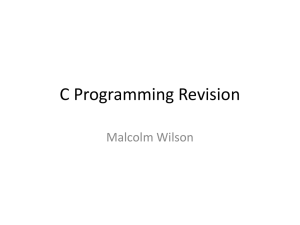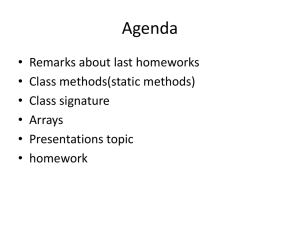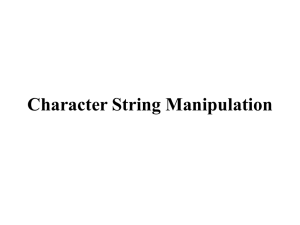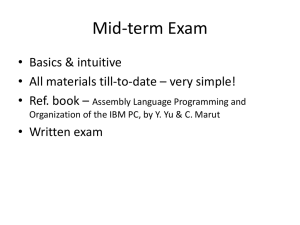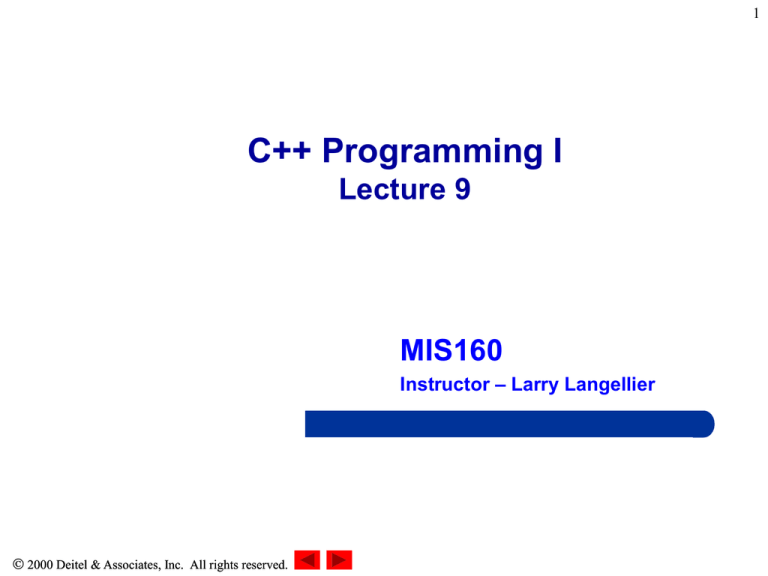
1
C++ Programming I
Lecture 9
MIS160
Instructor – Larry Langellier
2000 Deitel & Associates, Inc. All rights reserved.
2
Lecture 9 – Pointers and Strings
Outline
5.8
5.9
5.10
5.12
5.13
The Relationship Between Pointers and Arrays
Arrays of Pointers
Case Study: A Card Shuffling and Dealing Simulation
Introduction to Character and String Processing
5.12.1 Fundamentals of Characters and Strings
5.12.2 String Manipulation Functions of the
String-handling Library
Thinking About Objects: Interactions Among Objects
2000 Deitel & Associates, Inc. All rights reserved.
3
The Relationship Between Pointers and
Arrays
• Arrays and pointers closely related
– Array name like constant pointer
– Pointers can do array subscripting operations
– Having declared an array b[ 5 ] and a pointer bPtr
• bPtr is equal to b
bptr == b
• bptr is equal to the address of the first element of b
bptr == &b[ 0 ]
2000 Deitel & Associates, Inc. All rights reserved.
4
Pointers and Arrays
• Array elements can be accessed using pointer
notation also
• Example – ptrnote.cpp
• *(intarray + j) is equivalent to intarray[j]
• Adding a value to a pointer causes it to move that
many elements forward, not that many address
locations
• In the case of an integer, adding 1 would move you
2 bytes forward; for a double, adding 1 would move
you 8 bytes forward
2000 Deitel & Associates, Inc. All rights reserved.
5
Pointer Constants and Pointer Variables
• You may not use the increment operator to step
through array addresses – the starting address of the
array is a constant
• Although you can’t increment the address, you can
increment a pointer that holds the address
• Example – ptrinc.cpp
• The pointer variable can be incremented and used to
traverse the array
2000 Deitel & Associates, Inc. All rights reserved.
6
The Relationship Between Pointers and
Arrays
• Accessing array elements with pointers
– Element b[ n ] can be accessed by *( bPtr + n )
• Called pointer/offset notation
– Array itself can use pointer arithmetic.
• b[ 3 ] same as *(b + 3)
– Pointers can be subscripted (pointer/subscript notation)
• bPtr[ 3 ] same as b[ 3 ]
2000 Deitel & Associates, Inc. All rights reserved.
7
Arrays of Pointers
• Arrays can contain pointers
– Commonly used to store an array of strings
char *suit[ 4 ] = {"Hearts", "Diamonds",
"Clubs", "Spades" };
– Each element of suit is a pointer to a char * (a string)
– The strings are not in the array, only pointers to the strings
are in the array
suit[0]
’H’
’e’
’a’
’r’
’t’
’s’
’\0’
suit[1]
’D’
’i’
’a’
’m’
’o’
’n’
’d’
suit[2]
’C’
’l’
’u’
’b’
’s’
’\0’
suit[3]
’S’
’p’
’a’
’d’
’e’
’s’
’s’
’\0’
’\0’
– suit array has a fixed size, but strings can be of any size
• Example – ptrtostr.cpp
2000 Deitel & Associates, Inc. All rights reserved.
8
Case Study: A Card Shuffling and Dealing
Simulation
• Card shuffling program
– Use an array of pointers to strings, to store suit names
– Use a double scripted array (suit by value)
Ace
0
Hearts
0
Diamonds
1
Clubs
2
Spades
3
Two
1
2
Three Four Five Six
Seven Eight Nine Ten
Jack Queen King
3
4
5
6
7
8
9
10
11
12
deck[2][12] represents the King of Clubs
Clubs
King
– Place 1-52 into the array to specify the order in which the
cards are dealt
2000 Deitel & Associates, Inc. All rights reserved.
9
Case Study: A Card Shuffling and Dealing
Simulation
• Pseudocode for shuffling and dealing
simulation
First refinement
Initialize the suit array
Initialize the face array
Initialize the deck array
Second refinement
For each of the 52 cards
Place card number in randomly
selected unoccupied slot of deck
Third refinement
Choose slot of deck randomly
While chosen slot of deck has
been previously chosen
Choose slot of deck randomly
Place card number in chosen
slot of deck
Shuffle the deck
For each of the 52 cards
Deal 52 cards
Find card number in deck array
and print face and suit of card
2000 Deitel & Associates, Inc. All rights reserved.
For each slot of the deck array
If slot contains card number
Print the face and suit of the
card
1 // Fig. 5.24: fig05_24.cpp
2 // Card shuffling dealing program
3 #include <iostream>
4
5 using std::cout;
6 using std::ios;
7
8 #include <iomanip>
9
10 using std::setw;
11 using std::setiosflags;
12
13 #include <cstdlib>
14 #include <ctime>
15
16 void shuffle( int [][ 13 ] );
17 void deal( const int [][ 13 ], const char *[], const char *[] );
18
19 int main()
20 {
21
const char *suit[ 4 ] =
22
{ "Hearts", "Diamonds", "Clubs", "Spades" };
23
const char *face[ 13 ] =
24
{ "Ace", "Deuce", "Three", "Four",
25
"Five", "Six", "Seven", "Eight",
26
"Nine", "Ten", "Jack", "Queen", "King" };
27
int deck[ 4 ][ 13 ] = { 0 };
28
29
srand( time( 0 ) );
30
31
shuffle( deck );
32
deal( deck, face, suit );
2000
Deitel & Associates, Inc. All rights reserved.
33
Outline
1. Initialize suit and
face arrays
1.1 Initialize deck
array
2. Call function
shuffle
2.1 Call function deal
34
return 0;
35 }
36
37 void shuffle( int wDeck[][ 13 ] )
The numbers 1-52 are
3. Define functions
38 {
randomly placed into the
39
int row, column;
deck array.
40
41
for ( int card = 1; card <= 52; card++ ) {
42
do {
43
row = rand() % 4;
44
column = rand() % 13;
45
} while( wDeck[ row ][ column ] != 0 );
46
47
wDeck[ row ][ column ] = card;
48
}
49 }
50
51 void deal( const int wDeck[][ 13 ], const char *wFace[],
52
const char *wSuit[] )
53 {
Searches deck for the
54
for ( int card = 1; card <= 52; card++ )
card number, then prints
55
56
for ( int row = 0; row <= 3; row++ )
the face and suit.
57
58
for ( int column = 0; column <= 12; column++ )
59
60
if ( wDeck[ row ][ column ] == card )
61
cout << setw( 5 ) << setiosflags( ios::right )
62
<< wFace[ column ] << " of "
63
<< setw( 8 ) << setiosflags( ios::left )
64
<< wSuit[ row ]
65
<< ( card % 2 == 0 ? '\n' : '\t' );
2000
Deitel
&
Associates,
Inc.
All rights reserved.
66 }
Outline
Six of Clubs
Ace of Spades
Ace of Hearts
Queen of Clubs
Ten of Hearts
Ten of Spades
Ten of Diamonds
Four of Diamonds
Six of Diamonds
Eight of Hearts
Nine of Hearts
Deuce of Spades
Five of Clubs
Deuce of Diamonds
Five of Spades
King of Diamonds
Deuce of Hearts
Ace of Clubs
Three of Clubs
Nine of Clubs
Four of Hearts
Eight of Diamonds
Jack of Diamonds
Five of Hearts
Four of Clubs
Jack of Clubs
Seven of Diamonds
Ace of Diamonds
Queen of Diamonds
Seven of Hearts
Deuce of Clubs
Three of Spades
Four of Spades
Ten of Clubs
Six of Spades
Three of Diamonds
Three of Hearts
Six of Hearts
Eight of Clubs
Eight of Spades
King of Clubs
Jack of Spades
Queen of Hearts
King of Spades
King of Hearts
Nine of Spades
Queen of Spades
Nine of Diamonds
Seven of Clubs
Five of Diamonds
Jack of Hearts
Seven of Spades
2000 Deitel & Associates, Inc. All rights reserved.
Outline
Program Output
13
Function Pointers
• Pointers to functions
– Contain the address of the function
– Similar to how an array name is the address of its first element
– Function name is starting address of code that defines function
• Function pointers can be
– Passed to functions
– Stored in arrays
– Assigned to other function pointers
2000 Deitel & Associates, Inc. All rights reserved.
14
Function Pointers
• Example: bubblesort
– Function bubble takes a function pointer
• The function determines whether the the array is sorted into
ascending or descending sorting
– The argument in bubble for the function pointer
bool ( *compare )( int, int )
tells bubble to expect a pointer to a function that takes two
ints and returns a bool
– If the parentheses were left out
bool *compare( int, int )
would declare a function that receives two integers and
returns a pointer to a bool
2000 Deitel & Associates, Inc. All rights reserved.
1 // Fig. 5.26: fig05_26.cpp
2 // Multipurpose sorting program using function pointers
3 #include <iostream>
4
5 using std::cout;
1. Initialize array
6 using std::cin;
7 using std::endl;
8
Notice the function pointer 2. Prompt for
9 #include <iomanip>
ascending or
parameter.
10
descending sorting
11 using std::setw;
12
13 void bubble( int [], const int, bool (*)( int, int ) );
2.1 Put appropriate
14 bool ascending( int, int );
function pointer into
15 bool descending( int, int );
bubblesort
16
17 int main()
18 {
2.2 Call bubble
19
const int arraySize = 10;
20
int order,
21
counter,
3. Print results
22
a[ arraySize ] = { 2, 6, 4, 8, 10, 12, 89, 68, 45, 37 };
23
24
cout << "Enter 1 to sort in ascending order,\n"
25
<< "Enter 2 to sort in descending order: ";
26
cin >> order;
27
cout << "\nData items in original order\n";
28
29
for ( counter = 0; counter < arraySize; counter++ )
30
cout << setw( 4 ) << a[ counter ];
31
32
if ( order == 1 ) {
33
bubble( a, arraySize, ascending );
2000
Deitel
& Associates,
Inc. Allitems
rights reserved.
34
cout
<< "\nData
in ascending order\n";
Outline
35
}
36
else {
37
bubble( a, arraySize, descending );
38
cout << "\nData items in descending order\n";
39
}
3.1 Define functions
40
41
for ( counter = 0; counter < arraySize; counter++ )
42
cout << setw( 4 ) << a[ counter ];
43
44
cout << endl;
ascending and
45
return 0;
descending return true or
46 }
47
false. bubble calls swap if
48 void bubble( int work[], const int size,
the function call returns true.
49
bool (*compare)( int, int ) )
50 {
51
void swap( int * const, int * const );
// prototype
52
53
for ( int pass = 1; pass < size; pass++ )
Notice how function pointers
54
are called using the
55
for ( int count = 0; count < size - 1; count++ )
dereferencing operator. The *
56
57
if ( (*compare)( work[ count ], work[ count + 1 ] ) )
is not required, but emphasizes
58
swap( &work[ count ], &work[ count + 1 ] );
that compare is a function
59 }
pointer and not a function.
60
61 void swap( int * const element1Ptr, int * const element2Ptr )
62 {
63
int temp;
64
65
temp = *element1Ptr;
66
*element1Ptr = *element2Ptr;
67
*element2Ptr = temp;
2000
68 } Deitel & Associates, Inc. All rights reserved.
Outline
69
Outline
70 bool ascending( int a, int b )
71 {
72
return b < a;
// swap if b is less than a
3.1 Define functions
73 }
74
75 bool descending( int a, int b )
76 {
77
return b > a;
// swap if b is greater than a
78 }
Enter 1 to sort in ascending order,
Enter 2 to sort in descending order: 1
Data items in original order
2
6
4
8 10 12 89 68
Data items in ascending order
2
4
6
8 10 12 37 45
Program output
45
37
68
89
Enter 1 to sort in ascending order,
Enter 2 to sort in descending order: 2
Data items in original order
2
6
4
8 10 12 89 68
Data items in descending order
89 68 45 37 12 10
8
6
45
37
4
2
2000 Deitel & Associates, Inc. All rights reserved.
18
Fundamentals of Characters and Strings
• Character constant
– Integer value of a character
– Single quotes
– 'z' is the integer value of z, which is 122
• String
– Series of characters treated as one unit
– Can include letters, digits, special characters +, -, * ...
– String literal (string constants)
• Enclosed in double quotes, for example:
"I like C++"
– Array of characters, ends with null character '\0'
– Strings are constant pointers (like arrays)
• Value of string is the address of its first character
2000 Deitel & Associates, Inc. All rights reserved.
19
Fundamentals of Characters and Strings
• String assignment
– Character array:
char color[] = "blue";
• Creates 5 element char array, color, (last element is '\0')
– variable of type char *
char *colorPtr = "blue";
• Creates a pointer to string “blue”, colorPtr, and stores it in memory
• Avoiding Buffer Overflow
– Use setw( ) to limit the number of characters cin will
accept – one less than the width
– Example – safetyin.cpp
• String Constants
– You can initialize a string variable to a constant value
when you define it
char str[] = “Halloween is coming!!!”;
2000 Deitel & Associates, Inc. All rights reserved.
20
Just Do It!
Write a program that uses random-number generation to create sentences. The
program should use four arrays of pointers to char called article, noun, verb
and preposition. The program should create a sentence by selecting a word at
random from each array in the following order: article, noun, verb, preposition,
article and noun. As it word is picked, it should be concatenated to the
previous words in an array that is large enough to hold the entire sentence.
The words should be separated by spaces. When the final sentence is output it
should start with a capital letter and end with a period. The program should
generate 20 such sentences. The arrays should contain:
article:
noun:
verb:
preps:
“the”, “a”, “one”, “some”, “any”
“boy”, “girl”, “dog”, “town”, “car”
“drove”, “jumped”, “ran”, “walked”, “skipped”
“to”, “from”, “over”, “under”, “on”
2000 Deitel & Associates, Inc. All rights reserved.
21
Sample Solution
#include <iostream>
#include <cstdlib>
#include <ctime>
#include <cstring>
#include <cctype>
using namespace std;
const int SIZE = 100;
int main()
{
const char article[][10] = { "the", "a", "one", "some", "any" },
noun[][10] = { "boy", "girl", "dog", "town", "car" },
verb[][10] = { "drove", "jumped", "ran", "walked", "skipped" },
preposition[][10] = { "to", "from", "over", "under", "on" };
char sentence[ SIZE ] = "";
2000 Deitel & Associates, Inc. All rights reserved.
22
Sample Solution (cont.)
for ( int i = 1; i <= 20; ++i ) {
strcat( sentence, article[ rand() % 5 ] );
strcat( sentence, " " );
strcat( sentence, noun[ rand() % 5 ] );
strcat( sentence, " " );
strcat( sentence, verb[ rand() % 5 ] );
strcat( sentence, " " );
strcat( sentence, preposition[ rand() % 5 ] );
strcat( sentence, " " );
strcat( sentence, article[ rand() % 5 ] );
strcat( sentence, " " );
strcat( sentence, noun[ rand() % 5 ] );
cout << static_cast< char > ( toupper( sentence[ 0 ] ) )
<< &sentence[ 1 ] << ".\n";
sentence[ 0 ] = '\0';
}
cout << endl;
return 0;
}
2000 Deitel & Associates, Inc. All rights reserved.
23
Fundamentals of Characters and Strings
• Reading strings
– Assign input to character array word[ 20 ]
cin >> word
• Reads characters until whitespace or EOF
• String could exceed array size
cin >> setw( 20 ) >> word;
• Reads 19 characters (space reserved for '\0')
• cin.getline
– Reads a line of text
– Using cin.getline
cin.getline( array, size, delimiter character);
2000 Deitel & Associates, Inc. All rights reserved.
24
Fundamentals of Characters and Strings
• cin.getline
– Copies input into specified array until either
• One less than the size is reached
• The delimiter character is input
– Example
char sentence[ 80 ];
cin.getline( sentence, 80, '\n' );
2000 Deitel & Associates, Inc. All rights reserved.
25
Copying Strings
• The Hard Way – character by character
– Use a loop copying character by character from one array
to the other
– Example – strcopy1.cpp
– Library Function – strlen( )
• The Easy Way – using the strcpy( ) function
– The standard string library (cstring) provides a function
that will copy the contents of one string variable into
another – strcpy( )
strcpy(str2, str1);
– Example – strcopy2.cpp
2000 Deitel & Associates, Inc. All rights reserved.
26
String Manipulation Functions of the Stringhandling Library
• String handling library <cstring> provides functions to
–
–
–
–
Manipulate strings
Compare strings
Search strings
Tokenize strings (separate them into logical pieces)
• ASCII character code
– Strings are compared using their character codes
– Easy to make comparisons (greater than, less than, equal to)
• Tokenizing
– Breaking strings into tokens, separated by user-specified characters
– Tokens are usually logical units, such as words (separated by spaces)
– "This is my string" has 4 word tokens (separated by spaces)
2000 Deitel & Associates, Inc. All rights reserved.
27
String Manipulation Functions of the String-handling Library
char *strcpy( char *s1, const
char *s2 );
Copies the string s2 into the character
array s1. The value of s1 is returned.
char *strncpy( char *s1, const
char *s2, size_t n );
Copies at most n characters of the string s2
into the character array s1. The value of s1 is
returned.
char *strcat( char *s1, const
char *s2 );
Appends the string s2 to the string s1. The
first character of s2 overwrites the terminating
null character of s1. The value of s1 is
returned.
char *strncat( char *s1, const
char *s2, size_t n );
Appends at most n characters of string s2 to
string s1. The first character of s2 overwrites
the terminating null character of s1. The value
of s1 is returned.
int strcmp( const char *s1,
const char *s2 );
Compares the string s1 with the string s2. The
function returns a value of zero, less than zero
or greater than zero if s1 is equal to, less than
or greater than s2, respectively.
2000 Deitel & Associates, Inc. All rights reserved.
28
String Manipulation Functions of the String-handling Library (III)
int strncmp( const char *s1, const
char *s2, size_t n );
Compares up to n characters of the string
s1 with the string s2. The function returns
zero, less than zero or greater than zero if
s1 is equal to, less than or greater than s2,
respectively.
char *strtok( char *s1, const char
*s2 );
A sequence of calls to strtok breaks
string s1 into “tokens”—logical pieces
such as words in a line of text—delimited
by characters contained in string s2. The
first call contains s1 as the first argument,
and subsequent calls to continue tokenizing
the same string contain NULL as the first
argument. A pointer to the current token is
returned by each call. If there are no more
tokens when the function is called, NULL is
returned.
size_t strlen( const char *s );
Determines the length of string s. The
number of characters preceding the
terminating null character is returned.
2000 Deitel & Associates, Inc. All rights reserved.
29
Strings as Part of Other Types
• Arrays of Strings
– Strings are Arrays and we can have Arrays of Arrays
(multidimensional), therefor we can have Arrays of Strings
– Example – straray.cpp
– Accessing an individual String
star[j] – not star[j][i]
• Strings as Data Members
– Strings can be a Data Member for a struct
– Example – strpart.cpp
2000 Deitel & Associates, Inc. All rights reserved.
30
Just Do It!
Write a program that encodes English language words into pig Latin.
Pig Latin is a form of coded language often used from amusement. To
translate an English word into a pig Latin word, place the first letter
of the English word at the end of the English word and add the letters
“ay”. Thus the word “jump” becomes “umpjay”. Assume that all words have
two or more letters
You should have a function called printLatinWord() to display
the word. Feel free to use any string functions you find useful…
2000 Deitel & Associates, Inc. All rights reserved.
31
Sample Solution
#include <iostream>
#include <cstring>
using namespace std;
const int SIZE = 80;
void printLatinWord( char word[] )
{
int i;
int len = strlen( word );
for (i = 1; i < len; ++i )
cout << word[i];
cout << word[0] << "ay";
}
2000 Deitel & Associates, Inc. All rights reserved.
32
Sample Solution (cont.)
int main()
{
char word[ SIZE ];
cout << "Enter a word:\n";
cin.getline( word, SIZE );
cout << "\nThe word in Pig Latin is:\n";
printLatinWord( word );
cout << endl;
return 0;
}
2000 Deitel & Associates, Inc. All rights reserved.
33
Thinking (some more) About Objects
• This chapter
– Last OOD assignment before we begin study of OOP in
Chapter 6
– Focus on object collaboration
• End of section
– List of Internet and WWW UML resources (look in text)
– Bibliography of UML resources (look in text)
• Chapter 6
– Begin coding simulator
• Chapters 7, 9
– Required to complete simulator
2000 Deitel & Associates, Inc. All rights reserved.
34
Collaborations
• Collaboration - interaction between objects
1. Object of one class
2. Sends message
3. Received by object of another class
– Message invokes operation of second class
– In Chapter 4, we determined many operations
• Now, we focus on the messages that invoke them
• Next slide
– List of verb phrases that correspond to operations
• Some phrases removed from complete list of all verbs
– Remaining phrases are collaborations
2000 Deitel & Associates, Inc. All rights reserved.
35
Collaborations (II)
Cla ss
Verb p hra ses
Elevator
resets the elevator button, sounds the elevator bell, signals its
arrival to a floor, opens its door, closes its door
Clock
Scheduler
ticks every second
tells a person to step onto a floor, verifies that a floor is
unoccupied
Person
presses floor button, presses elevator button, enters elevator,
exits elevator
Floor
resets floor button, turns off light, turns on light
FloorButton
summons elevator
ElevatorButton signals elevator to prepare to leave
Door
(opening of door) signals person to exit elevator, (opening of
door) signals person to enter elevator
Bell
Light
Building
increments the time, gets the time, provides the time to the
scheduler, provides the time to the elevator
2000 Deitel & Associates, Inc. All rights reserved.
36
Creating Collaborations
• Creating Collaborations
– Examine list of verbs
– "resets elevator button" in class Elevator
– To do this:
• Elevator object sends resetButton message to
ElevatorButton object
• This invokes resetButton operation
• Next slide
– List of all collaborations that can be taken from our table of
verb phrases
2000 Deitel & Associates, Inc. All rights reserved.
37
Creating Collaborations (II)
An o b jec t o f c la ss
Send s the m essa g e
To a n o b jec t o f c la ss
Elevator
resetButton
ringBell
elevatorArrived
openDoor
closeDoor
ElevatorButton
Bell
Floor
Door
Door
Scheduler
stepOntoFloor
isOccupied
Person
pressButton
pressButton
passengerEnters
passengerExits
personArrives
Floor
resetButton
turnOff
turnOn
Person
Floor
FloorButton
ElevatorButton
Elevator
Elevator
Floor
FloorButton
Light
Light
FloorButton
summonElevator
Elevator
ElevatorButton
prepareToLeave
Door
exitElevator
enterElevator
Elevator
Person
Person
tick
getTime
processTime
processTime
Clock
Clock
Scheduler
Elevator
Clock
Bell
Light
Building
2000 Deitel & Associates, Inc. All rights reserved.
38
Collaboration Diagrams
• Collaboration diagrams
– Model interaction of objects
– Focus on which objects participate in interactions
– Similar to sequence diagrams, but sequence diagrams focus
on when interactions occur
• Format
– Rectangle - represents object, has name inside
– Solid lines - connect collaborating objects
• Message passed along direction shown by arrows
• Name of message by arrow
– Sequence of messages - numerical ordering of messages
2000 Deitel & Associates, Inc. All rights reserved.
39
4.2:
Door
sends
message to waitingperson
3: Elevator
4: Elevator
notifies
opensfloor
doorofenterElevator
arrival
5.4
Collaboration
Diagrams
4.1:
Door
4.2.1
sends
passengerEnters
exitElevator
message
to
passenger
3.1:
Floor
resets
its
button
1: Elevator resets button
passengerExits
3.2:4.1.1
Floor
(This
turns
sequence
on its light
ensures that a person exits before another enters)
2: Elevator
rings
bell
: FloorButton
: Light
3.1: resetButton( )
3.2: turnOn( )
: Floor
3: elevatorArrived( )
4.2.1: passengerEnters( )
waitingPassenger : Person
4.1.1: passengerExits( )
: Elevator
passenger : Person
1: resetButton( )
2: ringBell( )
: Bell
: ElevatorButton
4: openDoor( )
4.2: enterElevator( )
4.1: exitElevator( )
: Door
2000 Deitel & Associates, Inc. All rights reserved.
40
Summary
• Reasonably complete listing of classes
– Chapter 6 - implement large portion of simulator
– Chapter 7 - implement complete, working simulator
– Chapter 9 - discuss inheritance
• Summary of object-oriented design process
0. Analysis phase - meet with clients, gather information
• Create use cases to describe how users interact with system
• In this example, began with problem statement (no analysis
phase)
1. Classes - locate classes by listing nouns in problem
statement
• Eliminate nouns that are attributes of classes, and nouns that
are not part of the system
• Create a diagram that models classes and associations
2000 Deitel & Associates, Inc. All rights reserved.
41
Summary
• Summary of OOD process (continued)
2. Attributes - extract attributes by listing words that describe
classes
3. Dynamic Nature - create statechart diagrams to learn how
classes change over time
4. Operations - examine verbs associated with each class
• Extract operations
• Use activity diagrams to model details of operations
5. Collaborations - examine interactions between objects
• Use sequence and collaboration diagrams
• Add attributes and operations as needed
• Design
– We are probably missing a few pieces
– This will become apparent as we implement the simulator in
Chapter 6
2000 Deitel & Associates, Inc. All rights reserved.



